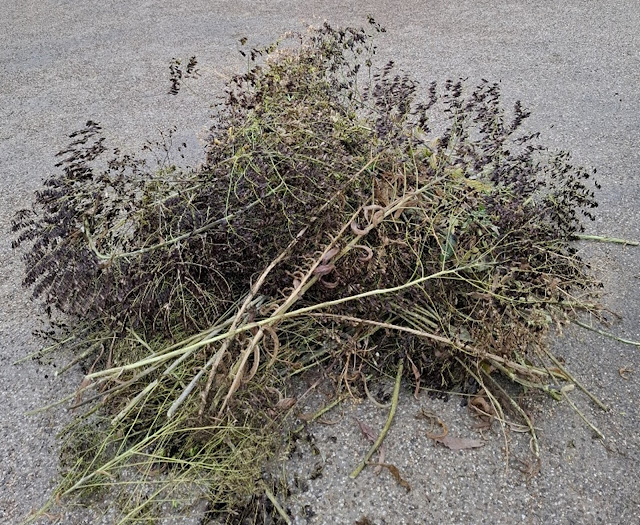It's time for the latest blog from our dedicated team of volunteer gardeners at Pontefract Castle.
Find out more about their blog series here.
Following Carole’s free talk last Saturday (in the rain - but no one seemed to mind), it was time for the start of the “great cut back”. So down came the woad, purple comfrey, green alkanet, Jacob’s ladder and the sages. These will all grow back again this year, and some will also re-flower.
Helen took sage cuttings for selling later in the year. Caroline and Louis pricked-out some angelica, motherwort and goat’s rue seedlings. Weeding was still to be done and the sales barrow was re-stocked with liquorice, dahlias, white cosmos and asters.
 |
| It took two people over four trips to clear all this woad! |
Plant of the Week: Chicory
It has been suggested that chicory’s other name 'succory' came from the Latin 'succurrere' (to run under), because of the plant's tap root. It may, however, be a corruption of 'Ctchorium', a word of Egyptian origin. In various forms, this is the name of the plant in many European languages.
Chicory has many other names such as blue daisy, blue dandelion, ragged sailors, wild bachelor's buttons and wild endive.
 |
| Chicory plants in flower in the Medieval Herb Garden |
Chicory is a woody, herbaceous perennial originally from Western Europe and North Africa. It grows on roadsides, waste places and other disturbed areas. It prefers to be South-facing, in any well-drained, but not heavy, clay soil.
With a deep tap root, it can grow to a height of 5ft. The stems of the plant appear from a tough, grooved and hairy stem. The general appearance of the plant is "stiff and angular" as the lateral branches are set at a wide angle to the stem. The leaves are stalked, lanceolate (narrow oval shape with pointed end) and unlobed. They range from 3 to 12.5 inches in length and 0.75 to 3.25 inches wide. The leaves become smaller as they occur up the plant.
Chicory flowers in early Summer. There are many daisy-like flowerheads, generally in clusters of two or three. The flowers are 1.25 - 2 inches wide, and usually light blue. Rarely, it can also flower white and, even rarer, pink. The MHG has all three colours!
Of the two rows of petals, the inner is longer and erect. The outer is shorter and spreading. However, by early afternoon the flowers close.
.jpg) |
| Blue and white chicory flowers falling through fennel fronds |
Culinary uses of chicory
Raw chicory leaves are 92% water, 5% carbohydrates, 2% protein, and contain next to no fat. They provide 23 calories (96 J) per 100g. They also have significant amounts (more than 20% of the recommended daily allowance) of vitamin K, vitamin A, vitamin C, some B vitamins and manganese. Vitamin E and calcium are present in moderate amounts.
It can be eaten raw as salad leaves and used to flavour bitter herbal custards and omelettes. The root can be baked or roasted. Chicory can also be boiled as a root vegetable, as long as the water is changed a few times to reduce the bitterness.
Chicory can be 'forced' like rhubarb. Deprived of light, the young leaves become blanched and greatly elongated. These leaves are soft and nearly free of the bitter flavour present when the plants are grown in the open air.
Globally, chicory is used as a coffee additive or replacement. Pure chicory drinks are also available. They are said to taste like coffee but with a slightly woody and nutty taste. This drink contains less caffeine than coffee.
Folklore and other facts about chicory
There are very similar stories about the origins of chicory from Roman, Greek, pre-Celtic and German folklore. Though slightly different in detail, they all contain the idea of a woman waiting or watching for her lover to return.
If the rare white flowers were placed under the linen shawl of a pregnant woman, it was supposed to make birthing easier.
It was valued for its ability to ward off evil spells or bad luck. The root was worn as a protective amulet, as it could break any magical spell.
Chicory has long been associated with coffee. In 1766 Frederick the Great banned the importation of coffee into Prussia. In response, Brunswick innkeeper Christian Gottlieb Förster invented a chicory coffee substitute.
It was also used in the UK during the Second World War. 'Camp Coffee', a coffee and chicory essence, has been on sale since 1885.
Chicory has been shown to reduce the severity of parasitic nematode infection in cattle.
Medieval uses*
Chicory was used in many European and North African countries and by native American tribes. The plant juice was used as a remedy for diarrhoea. The leaves and flowers were applied to boils and infected wounds, skin rashes, gout and to sore, inflamed eyes.
The root was widely used for gall bladder and kidney disorders, gastroenteritis and digestive problems, and for diseases related to the liver and spleen.
However, when taken too freely, it can cause pooling of blood in the digestive organs. If used to excess it is said to lead to sight loss.
*As always, this isn't to be considered medical advice today. Please don't use any plants mentioned in these blogs as medicine without advice from a doctor.

No comments:
Post a Comment
We would love your comments - though they may take a day or two to appear.